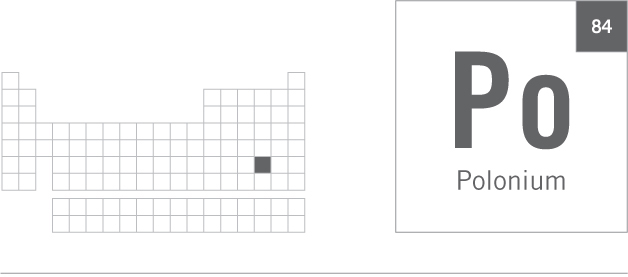Though Po was wrung from pitchblende ore through dogged Curie-osity,
Today ’tis made when neutrons bash big bismuth with velocity.
It heats and glows, decays away,

Though Po was wrung from pitchblende ore through dogged Curie-osity,
Today ’tis made when neutrons bash big bismuth with velocity.
It heats and glows, decays away,
“poe,” rhymes with “toe”
GROUP 16 METALLOID
Polonium is a soft, radioactive, silvery-gray metalloid discovered in Paris in 1898 by Marie Skłodowska Curie (1867–1934) and her husband Pierre Curie (1859–1906). Marie wondered why the uranium oxide ore pitchblende emitted four times more radioactivity than uranium and hypothesized that something other than uranium was responsible. Through dogged perseverance and painstaking effort, she managed to separate and isolate a sample containing the source of the surplus radioactivity, a new element that she named polonium after her native Poland. For this, and for their discovery later in 1898 of another radioactive element (see “Radium, Ra” on page 256), Marie and Pierre were jointly awarded one half of the Nobel Prize in Physics in 1903 “in recognition of the extraordinary services they have rendered by their joint researches on the radiation phenomena discovered by Professor Henri Becquerel.” The other half share went to the French physicist Henri Becquerel (1852–1908) “in recognition of the extraordinary services he has rendered by his discovery of spontaneous radioactivity.”
The once arduous task of extracting polonium from uranium ores is no longer necessary. Instead, the entire global commercial supply of polonium is now produced at the Ozersk nuclear reactor (to the east of the Ural Mountains in Russia). Atoms of bismuth-209 are bombarded with neutrons in the reactor, producing bismuth-210, which subsequently decays to form polonium-210.
Polonium-210 has a half-life of only 138 days and decays via the emission of alpha particles. These particles are essentially nuclei of helium, containing two protons and two neutrons (in other words, helium ions, He2+). The charged alpha particles ionize the surrounding air as they escape in droves from the element’s surface, producing in the dark a spectacular blue-white glow. The emissions are accompanied by the release of heat: polonium’s emission is so intense that 1 g of the element will self-heat to about 500°C. This property has made polonium a useful and lightweight heat source on space satellites.

Trace amounts of polonium have been incorporated into the antistatic devices used in the electronics, textiles, and printing industries. The steady and intense emission of charged alpha particles from the polonium neutralizes any localized buildups of static charge.
“pose,” rhymes with “rose”
Polonium’s emitted alpha particles pose little threat to human health because they typically only travel a few centimeters before bumping into molecules in the air. (The particles, if present outside the body, are also incapable of penetrating skin.) But if the alpha particles manage to enter the body, the threat changes dramatically. A recent example of this is the notorious death of the disaffected dissident KGB agent, Alexander Litvinenko, in London in 2006. Litvinenko died in agony three weeks after drinking from a cup of green tea spiked with a few micrograms of polonium-210. The polonium, once ingested, swiftly moved via his bloodstream to the cells of his organs, where it emitted its highly reactive and ferociously destructive alpha particles. A United Kingdom judicial inquiry in 2016 affirmed a long-held claim that Litvinenko’s poisoning was carried out by those working on behalf of his former Russian employers, an accusation they staunchly refuted. The case highlights polonium’s notoriety as one of the deadliest of all substances: its maximum safe body burden is a mere 7 picograms (pg, or 7 × 10–12 g or 0.000000000007 g).
